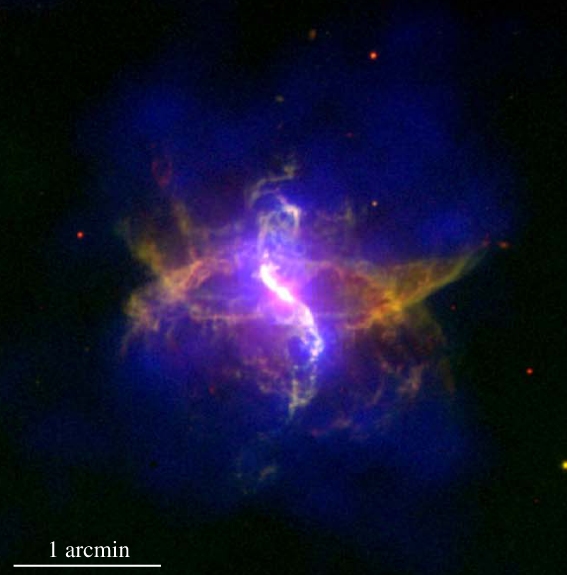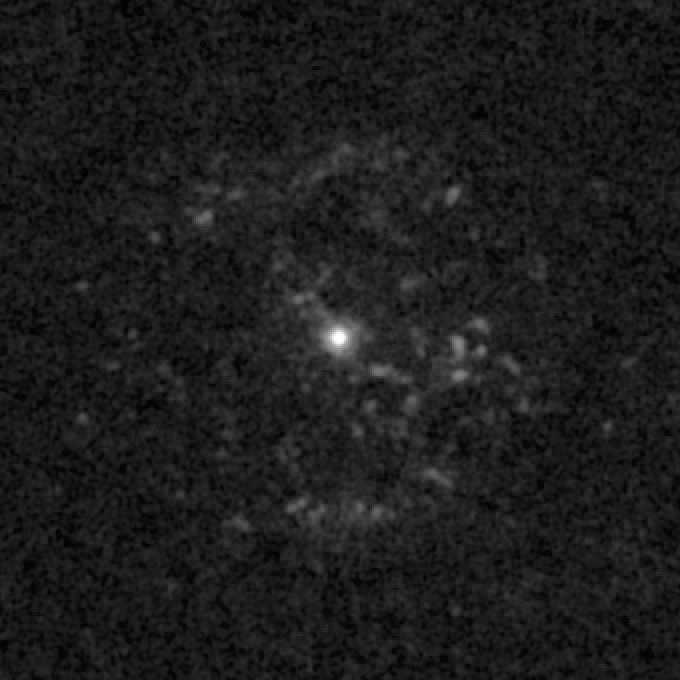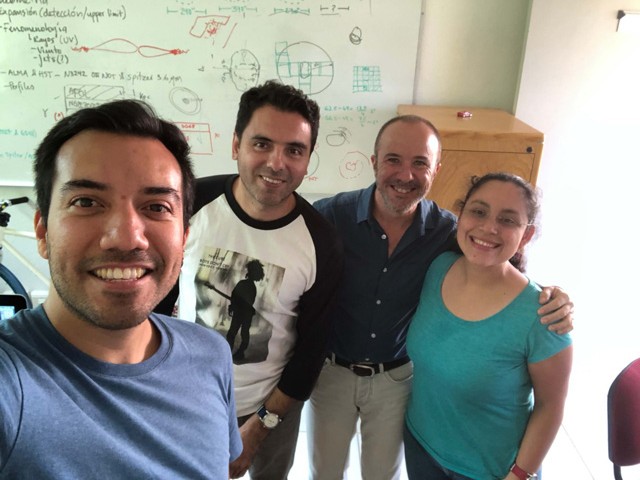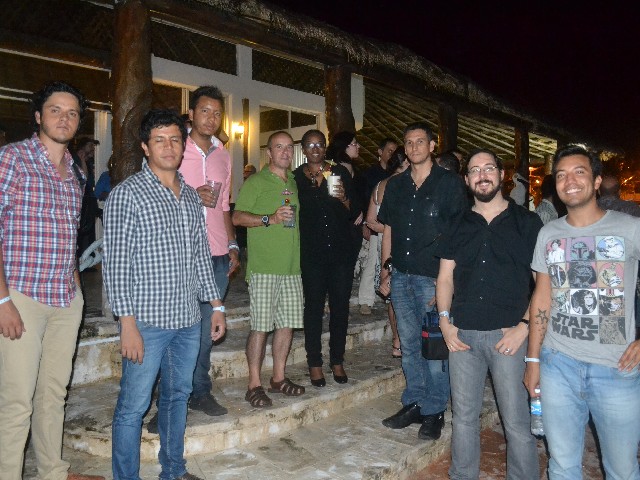HIGHLIGHTS
-
2024

SHAPING THE NEBULA AROUND THE SYMBIOTIC SYSTEM R AQUARII
Monthly Notices of the Royal Astronomical Society
-
This work analyse high-dispersion spectroscopic observations of the symbiotic system R Aquarii (R Aqr) obtained with the Manchester Echelle Spectrograph at the 2.1-m telescope of the San Pedro Martir Observatory (Mexico) in conjunction with available narrow-band images. The data are interpreted by means of the SHAPE software to disclose the morpho-kinematics of the nebulosities associated with R Aqr. The model that best reproduces narrow-band images and position–velocity diagrams consists of three structures: an outer (large) hourglass structure surrounding an inner bipolar with a spiral-like filament entwined around the latter.

3D PHYSICAL STRUCTURE AND ANGULAR EXPANSION OF THE REMNANT OF THE RECURRENT NOVA T PYX
Monthly Notices of the Royal Astronomical Society
-
We present the analysis of archival Very Large Telescope (VLT) Multi-Unit Spectroscopic Explorer (MUSE) and multi-epoch Hubble Space Telescope (HST) Wide Field Planetary Camera 2 (WFPC2) and Wide Field Camera 3/Ultraviolet-Visible Imaging Spectrograph (WFC3/UVIS) narrow-band observations of the remnant associated with the ejecta of the mid-nineteenth century outburst of the recurrent nova T Pyx. These data sets are used to investigate its true three-dimensional (3D) physical structure and the nebular expansion patterns along the line of sight and on the plane of the sky. The comparison of multi-epoch HST WFPC2 and WFC3/UVIS narrow-band images and VLT MUSE emission-line maps of T Pyx reveals the angular expansion of the remnant through the proper motion of individual knots and nebular features.
2023
EMERGING PLANETARY NEBULAE WITHIN 3D SPIRAL PATTERNS
Monthly Notices of the Royal Astronomical Society
-
We present the first 3D radiation-hydrodynamic simulations of the formation of planetary nebulae (PNe) emerging from 3D spiral patterns. We use the GUACHO code to create 3D spiral structures as a consequence of the distortions on the geometry of the intrinsically isotropic wind of an asymptotic giant branch (AGB) star produced by a companion star in a circular orbit. We found that the orbital period of the binary producing the 3D spiral pattern has consequences on the formation and shaping of the PN itself. Stellar systems with longer period create less entwined 3D spirals, producing PNe with rounder inner cavities, and prevent the expansion of jet towards the polar directions. The spiral fitting procedure used in the literature to predict the binary's orbital period may be misleading in the case of proto-PNe and PNe as spiral patterns are diluted by their own thermal expansion down to the average AGB density profile within a few hundred years and are further disrupted by the action of jets. By adopting a phase of jet ejections between the AGB and post-AGB stages, we are able to recover the morphologies of proto-PNe and PNe that exhibit ring-like structures in their haloes.

NGC 2022, A CASE STUDY OF A MULTIPLE-SHELL PLANETARY NEBULA
Monthly Notices of the Royal Astronomical Society
-
We present a detailed study of the physical properties, history of mass loss, and chemical abundances of the planetary nebula NGC 2022. New imaging observations obtained with the OAJ/JAST80 and NOT/ALFOSC confirm the presence of a faint halo surrounding a double-layered elliptical structure. The long-slit high-dispersion echelle observations obtained with MES on the OAN-SPM 2.1-m telescope can be well described by a SHAPE model. We have also used new intermediate-dispersion optical spectra with the NOT, complemented with IUE data, to study the chemical abundances of each shell. The abundances of the three shells are typical of a Type II in the Peimbert classification of PNe and do not exhibit any notable anomalies.
Featured
THE INSIDE-OUT PLANETARY NEBULA AROUND A BORN AGAIN STAR
-
Nature Astronomy
Here, we report on the exceptional case of HuBi1, a double-shell planetary nebula whose inner shell presents emission from low-ionization species close to the star and emission from high-ionization species farther away. Spectral analysis demonstrates that the inner shell of HuBi 1 is excited by shocks, whereas its outer shell is recombining. (Nature Astronomy | Vol 2 | October 2018 | 784–789)

DON'T STOP NOVAE
-
Ancients coined the term “novae” to describe the appearance of new stars in the sky that faded away after a few weeks or months. As comets and eclipses, these were considered premonition for future events. Nowadays, astronomers use this term to designate an explosive event on the surface of a white dwarf star, a compact stellar remnant with the mass of our Sun compressed to the size of the Earth. In a nova event, the material accreted onto the surface of the white dwarf from a late type binary companion reaches a critical mass and, under the effects of the high gravity of the white dwarf, a thermonuclear runaway is ignited. Material is ejected at speeds of hundreds to even a few thousands km/s in a nova explosion. This material forms a nova shell that expands swiftly, and soon can be resolved by space and ground-based telescopes.
The expansion of nova shells can be witnessed in time-scales of decades or even only a few years in some cases (e.g., Sab 142, Santamaría et al. 2019). Textbook models based on simple assumptions predict that the expansion velocity of a nova shell slows down to 50% of its initial value after 50—100 years. To test this classical prediction, high-quality images of nova shells in astronomical archives have been complemented with contemporary sub-arcsec images obtained at the Nordic Optical Telescope in the island of La Palma to investigate the present expansion of five nova shells with ages ranging from 50 to 130 years (Santamaría et al. 2020). Contrary to the theoretical expectations, the nova shells in our sample have a free expansion that will take effect until their very end, when they dilute into the interstellar medium (Santamaría et al. 2022). Apparently, the mechanical energy and momentum of the material in a nova shell is sufficiently large to sweep away the circumstellar material around the white dwarf. The expansion of the nova shells included in this study is notable in the “timelapse” movie of DQ Her, a cataclysmic variable system that experienced an outburst on December 1934.
Awards
Jesús Alberto Toalá Sanz
Winner Cátedra de Investigación Marcos Moshinsky 2020-
Fundación Marcos Moshinsky
With this project, Jesús Toalá intend to search and characterise the extended X-ray emission produced in novae explosions through the analysis of high quality observations and unprecedented numerical simulations trying to search for clues in order to understand nova events.

Laurence Sabin
Winner Cátedra de Investigación Marcos Moshinsky 2019-
Fundación Marcos Moshinsky
Through the development of Magneto-Hydrodynamic models combined with polarimetric (spectrum and observations), Laurence Sabin will study the magnetic fields in evolved Solar-type stars. The project aims to define the dynamic effects of stellar magnetism on the envelopes of these objects and to study the processes of magnetic release of material.

Gerardo Ramos Larios
Winner Cátedra de Investigación Marcos Moshinsky 2017-
Fundación Marcos Moshinsky
By means of high-resolution 2D hydrodynamic simulations, our group studied evolved stars and planetary nebulae that have rings and arcs around them. We found that the interaction of the central star's fast wind and the ionization flux, eventually disrupt and destroy these arcs and rings.
Gallery
Morelia, Mexico 2018 
Guadalajara, Mexico 2019 
APN7, Hong Kong 2017

Granada, Spain 2018 
Granada, Spain 2019 
Granada, Spain 2019

Guadalajara, Mexico 2021 
Granada, Spain 2022 
Granada, Spain 2022

Guadalajara, Mexico 2022 
Morelia, Mexico 2023 
Morelia, Mexico 2023

Granada, Spain 2018 
Ensenada, Mexico 2019 
Leiden, Netherlands 2019
Kraków, Poland 2023 
Morelia, Mexico 2024 Kraków, Poland 2023

APN6, Mexico 2013 
OAN-SPM, Mexico 2020 
Morelia, Mexico 2019
-